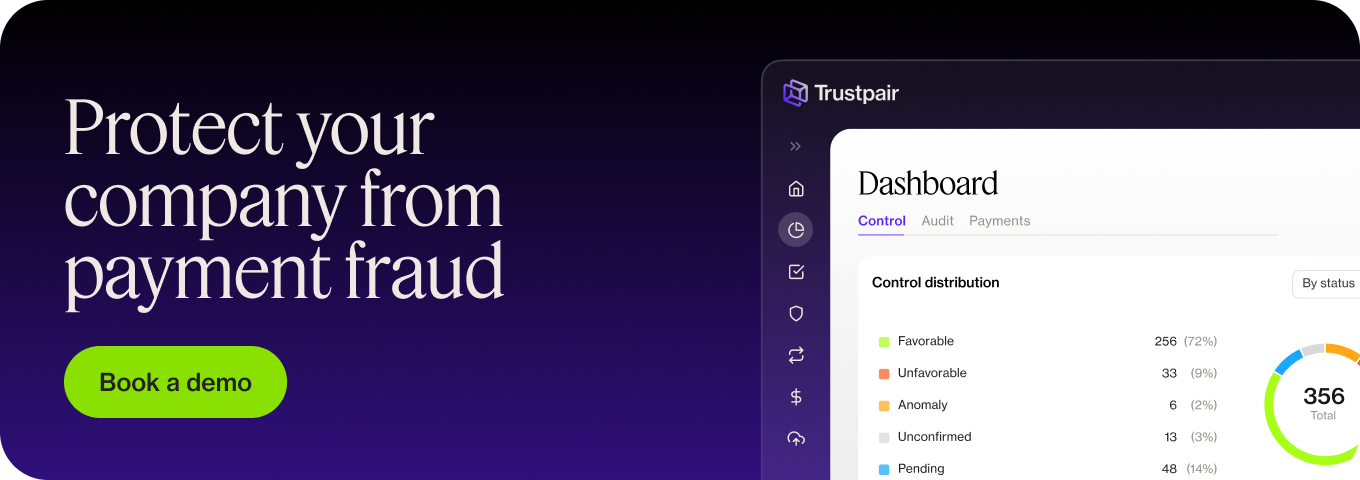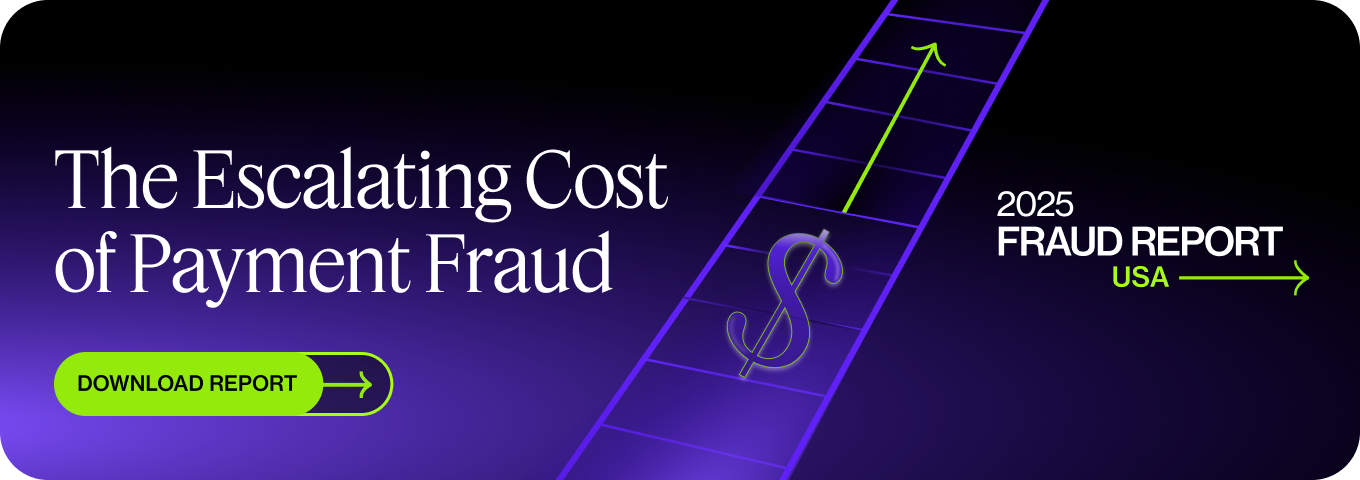In 2023, at least one fraud attempt targeted 96% of US companies. Successful fraud attacks have a massively negative impact on companies, both from a financial point of view and also in terms of reputation. It’s crucial to set up policies and procedures to protect yourself, like the 4-eyes principles. But is it enough? Keep reading this article to learn about the 4 eyes principle in finance and how much protection it really gives you against fraud.
Trustpair effectively wipes payment fraud by continuously auditing supplier data and payments, blocking any suspicious payment. Contact an expert to learn more!
What is the 4-eyes principle?
A definition of the 4 eyes principle
The four-eyes principle means involving different people and tools throughout an operation’s lifecycle. Each verification step of your approval process is given to different employees in order to improve overall security.
When talking about wire transfer scams specifically, companies must ensure people in charge of payment initiation and verifying payments are different. Although it takes longer to do, it decreases the risk of fraud.
The 4-eyes principle follows the concept of segregation of duties, stating that no employee should be in the position to both commit and conceal fraud or errors. Each important activity is done by someone different in order to decrease the risk of scams and fraud. Having clearly limited scopes for your staff is key to an efficient authorization process.
The 4 eyes principle also requires establishing a contingency plan. If an employee detects a scam attempt (or a mistake), they need to know how to react to protect the business.
Your protocol needs to include a chain of command for approval as well as clear management of payment limits. That can look like designing administrators for your software or giving your employees different permissions. It’s especially necessary when your organization’s transactions are big in volume and quantity.
4-eyes-principle examples
This principle should become a standard practice for key operations in your organization – from your project management to finances. Setting up efficient departmental approval workflows will streamline your business processes as well as improve your security. Below are some examples of how it can be useful.
Applying the 4 eye principle is especially useful when it comes to financial transactions. For example, you’d want someone different for data input and data verifications in your TMS – both using different user authentications and with different levels of approval.
The same goes for payment campaigns (for payroll or suppliers). You need:
- A person who initiates the payment campaign
- A reviewer for review and approval (approve or deny) of payments.
To effectively protect yourself from fraud, you also need to include third-party protection. Specifically, you need to consider your supplier risk management. Another example of 4-eyes-principle application.
The 4 eye principle applied to your vendor management looks like this:
- Adding all financial information that belongs to your supplier into your third-party master file.
- Updating your file consistently throughout your business relationship. If your supplier requests to change their bank details for instance, you need to carry out a proper verification (including three-way matching) before adding them to your file.
- Asking someone else to carry out a second verification before approving and releasing payment.
Depending on the size of your company, this workflow process can be more complex (and more secure).
How does the 4-eye principle block fraud?
Reducing human mistakes and internal fraud
By definition, the 4 eye principle segments the steps that constitute your payment chain.
Regardless of the attack angle of a potential fraudster, following this principle means that several employees will intervene throughout your payment chain. The goal is clear: reinforcing your approval process for increased protection.
By calling on at least two different pairs of eyes (so, 4 eyes in total) to check the financial information, your company reduces the risk of a potentially damaging oversight. It’s also harder for someone who might gain unauthorized access to an employee’s username and password to carry out their scheme.
But despite having several people involved, this methodology isn’t failproof because it’s manually carried out.
A limited option that remains manual
Today, changes in third-party credentials are the number one way hackers commit fraud. And yet, based on the same recent study, 70% of companies still use phone calls to check their changes in supplier financial information.
What does that mean? That the 4-eye principle remains a labor-intensive and easily breachable process.
Fraudsters can commit their bad deeds through a variety of techniques – which is why companies should constantly be looking at ways to reduce their fraud exposure.
For each of those frauds, scammers can easily find a breach in your system:
- CEO fraud: when fraudsters impersonate your CEO (or another member of your management) asking for an urgent and/or confidential transfer to be done. Here, the 4-eye principles will create a first layer of protection against falling victim to this attack – unless 2 staff members fall for this trap.
- Vendor fraud: impersonation of a known supplier can be done through emails or phone calls. The fraudster asks for their bank information to be modified. In this case, checking the financial information isn’t counterfeit can be tedious as your team must look up international databases. Your employees also need to do a callback to the vendor whose data are in your third-party master file to authenticate the request.
- Internal fraud: because they have authorized access to your master file, one of your employees could very well change a supplier’s credentials with their own. It’s very difficult for this type of scam to be detected without proactive detective controls.
While it’s necessary to follow the 4 eyes principle segregation of duties in your company, it’s nowhere near enough to completely safeguard your business against fraud.
Do you want to learn more about B2B fraud? Download our latest report!
Reinforce your protection measures against fraud
Although the 4-eye principle is necessary, it’s not enough to fight against fraud. In order to completely eradicate the risks, you need to have some added layers of protection.
One way to do that is by reviewing your authentication flow: for example, using multi factor authentication, or using a system that generates one-time passwords.
But the most effective measure is using fraud prevention software that will block any payment fraud attempt and spot any anomaly in supplier data or payments.
As we’ve seen, manual approvals are corruptible, error-prone as well as time-consuming. Control mechanisms are only partially effective, which gives your business weak protection against fraud attempts.
Systematic third-party controls must become standard in your company, which needs to ensure that they are correctly carried out. Using a digital platform that automates third-party checks like Trustpair is a smart choice to eradicate the risk of fraud. Goodbye, tedious manual checks! We systematically check your third-party information in real time so you can remain confident your payment chain is secure from end to end. On top of that, we integrate with many tools like SAP, Ivalua or JAGGAER, enhancing user experience and security.
Using a tool like Trustpair alongside the 4-eye principle means increased protection for your organization. Adding automated third part checks to your payment process means it’s completely secure. Contact an expert to learn more!
Key Takeaways:
- Adding the 4-eye principle to your company provides increased protection against fraud. Because it requires a minimum of 2 people (4 eyes) for each payment step, it reduces the risk of CEO, vendor, and internal fraud.
- However, the 4-eye principle cannot single-handedly protect your company against fraud. For complete protection, you need to use fraud management software like Trustpair which carries automatic third-party checks in real-time.






